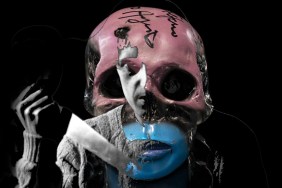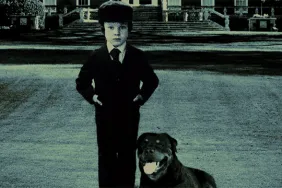Opening Friday, June 6th (limited)

Cast:
Asia Argento as Sarah Mandy
Cristian Solimeno as Detective Enzo Marchi
Adam James as Michael Pierce
Moran Atias as Mater Lachrymarum
Valeria Cavalli as Marta Colussi
Philippe Leroy as Guglielmo De Witt
Daria Nicolodi as Elisa Mandy
Directed by Dario Argento
Review:
These days, thanks to a wave of exhaustively violent films including High Tension, Frontier(s), and Inside, France is currently where all the most shocking genre fare is found. But in the ’80s, all the horror that mattered was imported from Italy. Back then, savvy genre fans were all about the Big Boot and were familiar with the work of filmmakers like Lucio Fulci, Ruggero Deodato, Umberto Lenzi, Michele Soavi, Andrea Bianchi, Luigi Cozzi (this reviewer’s initiation into the world of Italian horror was an unlikely viewing of Cozzi’s Alien Contamination on Elivra’s Movie Macabre!) and – most importantly – Dario Argento. At the time, with no other country able to compete on their level, it seemed like Italy would go on leading the pack forever.
Today, of course, the heyday of Italian horror is just a fond, blood-soaked memory. And while Argento continues on as one of Italy’s last active genre filmmakers, his current output barely merits comparison to the legendary work that made him a superstar in his homeland and a cult icon in the U.S.. His two installments for the Showtime series Masters of Horror (“Jenifer” and “Pelts”) were both moderately well received, however, and they showed that the maestro wasn’t completely out of the game. Thanks to the upswing given to Argento by his MoH work, when Mother of Tears – the long-awaited follow-up to Suspiria (1977) and Inferno (1980) – was announced as his next feature, it looked promising that he might be able to do justice to the finale of his “Three Mothers” trilogy.
Unfortunately, Mother of Tears is hard to rate as anything more than a disappointment. While Argento’s films have always resisted standard criticism, with reoccurring lackluster elements such as stilted dialogue or thin characterization being routinely dismissed as secondary to Argento’s style, this is still a botched effort. Even though it’s true that to fairly appreciate Argento’s work, one often has to adopt a different set of critical tools, it does a disservice to the many great films he’s made in the past to simply ascribe the poor quality of Mother of Tears to Argento’s ‘style’. Argento has long been called “the Italian Hitchcock” but with its risible dialogue, sub-par performances, and unintentional hilarity, Mother of Tears puts Argento in danger of becoming the Italian Ed Wood.
In its opening moments, the unexpected discovery of an arcane artifact kicks off MoT‘s storyline (the screenplay is penned by American writers Jace Anderson and Adam Gierash, who previously wrote Tobe Hooper’s films Toolbox Murders and Mortuary). After the excavation of a coffin in a church graveyard yields a sealed urn, Padre Milesi (Tommaso Banfi) sends the urn to the Museum of Ancient Art in Rome for further investigation. The urn is addressed to a specific curator but two museum workers – Dario’s daughter Asia (looking noticeably haggard) as Sarah and Coralina Cataldi-Tassoni as Giselle can’t resist being Those People in a horror movie who unknowingly unleash forces they can’t handle. And in Giselle’s case, she’s also the clumsy horror movie type who can’t help but cut themselves and bleed all over the most evil thing in the room.
Within minutes of opening the urn and accidentally spilling her blood on it, Giselle is set upon by the minions of Mater Lachymarum (whose ranks include a screeching monkey, by the way). What follows for Giselle doesn’t rank with the spectacular first murder in Suspiria but it is one of the nastier murders ever committed to film. “Overkill’ is the watchword in Mother of Tears and Argento doesn’t just subject his characters to hideous deaths, he completely violates them. Gorehounds should feel duty-bound to see this movie just for its revolting kills but without exception these set pieces are all clumsily staged in a way that the Argento of old would’ve never settled for.
Once Sarah stumbles onto the aftermath of Giselle’s death (in what may be an unconscious homage on Argento’s part, the sight of Giselle’s killers kneeling on the floor around her eviscerated body echoes the sight of zombies grouped around the similarly disemboweled body of Olga Karlatos in Lucio Fulci’s Zombie), the followers of Mater Lachymarum – monkey included – are immediately in pursuit. In the course of evading Mother Lachymarum’s lackeys and staying one step ahead of the violence that’s tearing Rome apart (a city-wide epidemic that’s depicted via several awkward and unconvincing vignettes that indicate this film’s limited budget), Sarah discovers that her late mother (played by her real-life mother Daria Nicolodi) was a white witch who once tried to beat the witch (Mater Suspiriorum, aka the Mother of Sighs) that Jessica Harper’s character of Suzy Bannion ultimately triumphed over in Suspiria.
Appearing as a glowing Obi-Wan-like apparition, Sarah’s mother guides Sarah as best she can (although her ‘help’ is mostly a matter of commanding Sarah to “Run!” or “Go!” – I would’ve thought a ghost could do better) as Sarah’s latent powers start to emerge. And while the significance of Nicolodi’s casting in this role is appreciated (besides being Asia’s mother, Nicolodi also collaborated with Dario Argento on the screenplays to Suspiria and Inferno), there’s just no way that a glowing ghost can be anything but a ridiculous addition to a film. It’s one of those situations where, just by trying, you’ve already lost.
As those around Sarah succumb to Mater Lachymarum’s forces (a gaggle of modern witches who are largely depicted as screeching, cackling Euro-trash), Sarah is left with few allies, either in the real world or on the spiritual plane. In the end, Sarah must stand alone against the satanic Mater Lachymarum (Moran Atias, who generously shares the role with her fake boobs) and viewers will be left to wonder what the Hell it is they just watched.
It’s ironic that Dimension Films is distributing Mother of Tears as this film looks as though they dismissed Argento in mid-production and replaced him with a director from their past roster of anonymous hacks like, say, Joe Chappelle. For all the signature Argento elements that Mother of Tears contains (even the monkey refers back to the simian star of Phenomena), the handwriting looks suspiciously forged. Once known for his exacting style and technical innovativeness, somewhere along the way Argento stopped being a perfectionist and Mother of Tears does little to reverse his turn towards sloppy filmmaking.
But even if this isn’t the return to form that his fans were hoping for (and despite the efforts of cinematographer Frederic Fasano, Mother of Tears provides none of the alchemical magic that past Argento collaborators such as Suspiria cinematographer Luciano Tovoli were able to deliver), I expect some Argento die-hards may still find something to appreciate here. France may currently be wearing the horror crown but between Asia Argento’s wasted heroine, the wholesale butchery of its cast (including some of the most misogynistic moments Argento has ever committed to film), and its determined monkey, the weird, violent and unruly sights of Mother of Tears will make older fans nostalgic for the days when they could count on the latest import from Italy to go to places where mainstream American horror movies wouldn’t.










